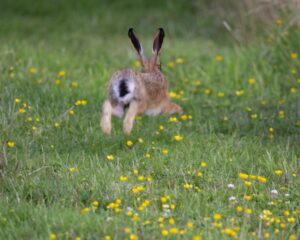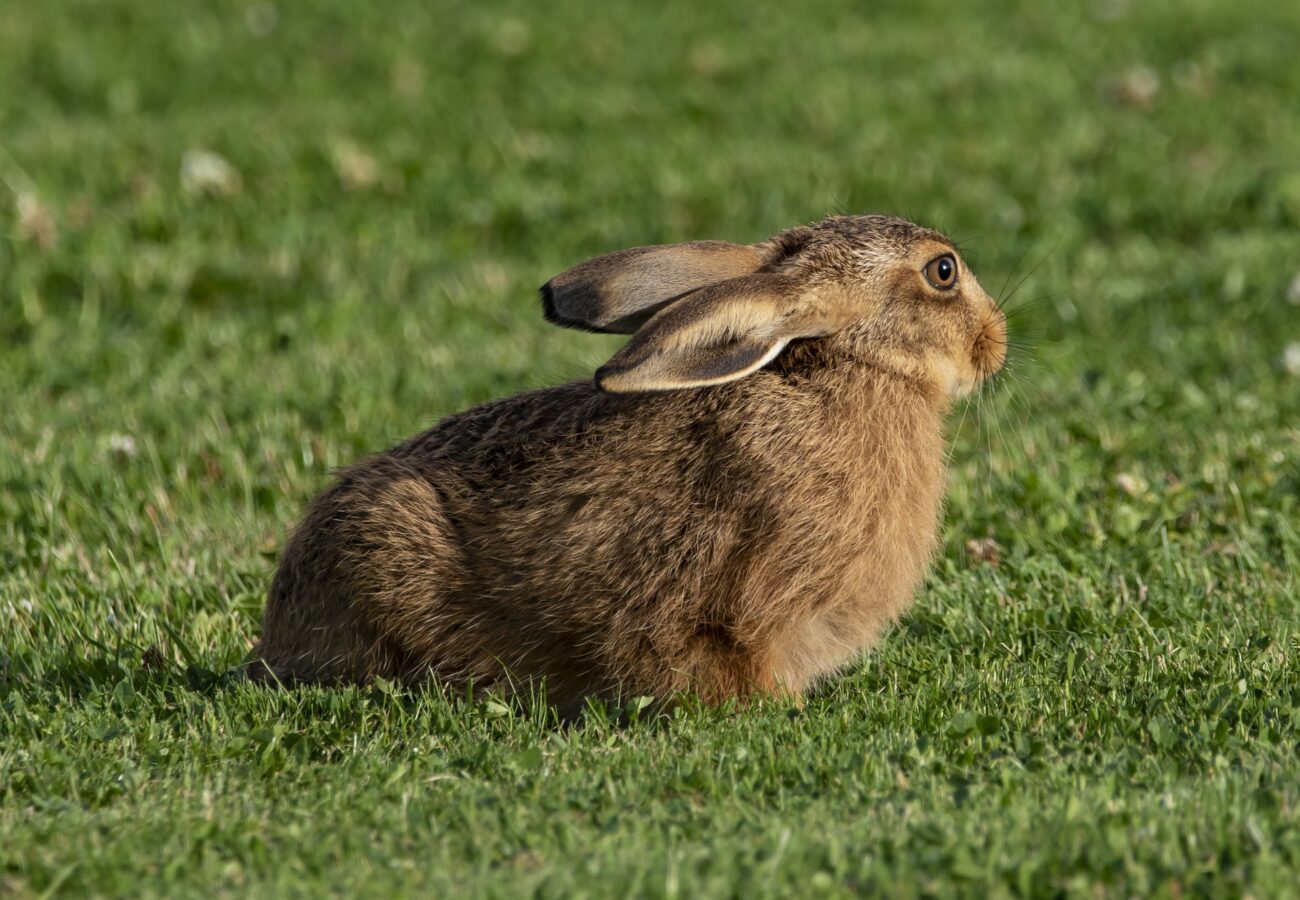Close season for hares: Your questions answered
Our Head of Policy, Dr Mark Jones tackles the most frequently asked questions we’ve received via social media about hares, hunting and the urgent need to take action to protect them.

Born Free has been campaigning for many years for a ban on hare shooting during their breeding season. This would help populations recover, while also protecting dependent leverets from being orphaned and preventing the needless suffering of countless individual animals.
In March 2025, Born Free’s Head of Policy, Dr Mark Jones spoke at a parliamentary event at the House of Lords, where Baroness Arminka Helic promoted the Private Members Bill that she introduced, which, if it becomes law, would ban hare shooting in their breeding season. We have backed the government e-petition calling for new legislation for a close season, which has so been signed by over 48,000 people, to date.
The campaign has received a huge response from people online – both for and against the proposal for a close season, so Dr Jones answers your most frequently asked questions below.
Why aren’t you campaigning for a total ban on shooting hares, rather than just a close season?
Born Free is opposed to the killing of any animal for sport or pleasure.
A total ban on hare shooting would be our preference, with farmers able to apply for a licence to humanely control hares where there is strong evidence for serious crop damage. The reason we are campaigning for a close season is we believe there is a real chance of achieving it, whereas the chances of persuading government to end the shooting of hares for sport altogether at this point are extremely slim.
Why are you campaigning for this – isn’t there already a close season for hares in place in the UK?
Most European countries restrict the open season for hare shooting to October-December which, in general, is the period when few adult females are pregnant or lactating. In some countries it extends into January.
Scotland introduced a close season for brown hares under the Wildlife and Natural Environment (Scotland) Act 2011, which protects brown hares from shooting from 1st February to the end of September. Scotland’s mountain hares were included on Schedule 5 of the Wildlife and Countryside Act 1981 from March 2021, and so have full protection. In Northern Ireland, the Game Preservation Act (Northern Ireland) of 1928 makes it “unlawful for any person to wilfully take, kill or destroy any hare from 1st February to 11th August”.
However, England and Wales are among the only countries in Europe that don’t operate a close season for hares, and hares are the only so-called ‘game’ species in England and Wales that are not legally protected from shooting during their breeding season.
A shooting industry Code of Practice was published in 2013, which contains some guidance to farmers, landowners and organisers of hare shoots, and generally advises against shooting after the end of February. However, this voluntary code has failed to prevent shooting during the breeding season.
The hare population is not under threat – in fact aren’t there more hares now than ever?

(c) Natural England
Numbers of brown hares, the predominant species in England and Wales, have reduced from perhaps as many as 4 million in the late 19th century, to less than 600,000 in 2022 based on British Trust for Ornithology Surveys. That’s something like an 85% decline in a century and a half. Brown and mountain hares were included in the UK’s Biodiversity Action Plan which ran from 1992 to 2012, and the brown hare was the subject of its own Species Action Plan, published in 1995.
However, the outcome fell far short of the ambitious goal of doubling the spring population by 2010. When the Action Plan was published the baseline population of brown hares was estimated to be around 750-800,000. The latest estimates from 2022 suggest this number has fallen to less than 600,000.
In England, mountain hares survive only in the Peak District (Derbyshire). Recent monitoring (2017–2024) indicates that they are in steep decline, and that populations have shrunk to perhaps less than 1,000 individuals.
Hares are threatened more by predators, such as kites, buzzards, foxes and badgers, than they are by hunting, so how would a close season help?
The major reasons for the decline in hare numbers include changes in land use and agricultural practices, but also include exploitation and persecution, in the form of shooting, poaching and coursing.
Predation, especially by foxes, does contribute to hare mortality – mainly among leverets. However, habitat loss, agricultural intensification, and changes in land management are far more significant long-term threats to UK hare populations. Badgers and birds of prey may opportunistically take leverets but are not considered to threaten hares at a population level. In well-managed landscapes with sufficient cover and food, hare populations can usually withstand natural predation levels.
Hare coursing is a bigger threat to hares than shooting them, isn’t it?
Hare coursing is an abominable activity that causes intense stress and suffering to hares. Those who practice coursing are also frequently involved in other types of rural crime, often cause extensive damage to land, crops and property, and may also threaten and intimidate farmers, landowners and others affected by their activities.
Hare coursing was banned under the Hunting Act 2004, but it continues illegally in many rural areas, particularly in eastern England (Lincolnshire, Cambridgeshire, Norfolk, Suffolk) and parts of Yorkshire. In these regions, coursing can remove large numbers of hares from local populations, especially in winter when hares are more visible in open fields.
The effect is most noticeable where populations are already under pressure from habitat loss or intensive agriculture. However, while coursing may have a significant impact at a localised level, it is not considered a major threat to hare populations nationally.
It’s very difficult to shoot a hare as they are so fast. With so few being shot, why is this an issue?
 Estimates, including from government agencies, suggest that 200,000-300,000 hares may be shot each year in England, predominantly for ‘sport’.
Estimates, including from government agencies, suggest that 200,000-300,000 hares may be shot each year in England, predominantly for ‘sport’.
An academic study published in 2017 by researchers at Bristol University modelled the impact of shooting practices on the risk of death by starvation of dependent young, and on hare population growth. It concluded that:
- Shooting hares in February, as is currently commonly practiced in England, leads to a profoundly damaging combination of population shrinkage and orphaning of leverets with consequent animal welfare impacts and poor population recovery outcomes;
- A close season from the start of February to the start of October provides capacity for population growth, and results in markedly reduced numbers of dependent juveniles being orphaned.
Are brown hares a native species?
Brown hares (Lepus europaeus) are not native to Britain — they were introduced from continental Europe by the Romans, most likely around the 1st century AD (roughly 2,000 years ago), for sport hunting and as a food source.
Mountain hares (Lepus timidus), are native to Scotland and parts of northern England.
What are the differences between hares and rabbits?
- Hares and rabbits both belong to the family Leporidae, alongside pikas. However, they belong to different genera and there are many stark differences in their appearance and life histories:
- Rabbits have compact bodies with short hind legs, short round-tipped ears and small rounded tails. Hares are leaner and taller with long ears and black-topped ‘scut’ tails.
- Newborn rabbits are blind, hairless, and helpless (altricial). Newborn hares are fully furred, have their eyes open, and are mobile (precocial).
- Rabbits live in social groups in networks of underground warrens and visit frequently to nurse their young. Hares live above ground alone or in loose social groups, give birth in shallow depressions or ‘forms’ in the ground, and leave their young alone hidden in vegetation, returning only to feed them.
- Rabbits are relatively slow and rely on retreating to their warrens for safety. Hares are fast (they can reach 45mph) and rely on speed and stealth for protection.
- Rabbits prefer grasslands, meadows and woodland edges with soft soil for digging. Hares prefer open country, such as farmland, moorland or upland heath.
- Rabbits mainly eat soft vegetation (grasses, young shoots). Hares eat tougher vegetation, including bark, twigs, and coarse grasses, especially in winter.
- Rabbits can breed several times a year, giving birth to litters of 4-12 kits, and typically have a lifespan of 1-3 years in the wild. Hares have fewer litters of 1-4 leverets and have a typical lifespan of 3-5 years in the wild.
- European rabbits (Oryctolagus cuniculus) were introduced by the Normans in the 12th century. Brown hare (Lepus europaeus) were introduced much earlier by the Romans in the 1st century AD.
TAKE ACTION
There’s still time to sign the petition to protect hares!
You can help by writing to your MP asking them to urge the Secretary of State for Environment to introduce a ‘close season’ for hare shooting without delay. A close season would bring England and Wales in line with the rest of Europe and give hares the same protection afforded to other ‘game’ species.

PROTECTING HARES
It’s high time our precious hares enjoyed the protection they so desperately need.
